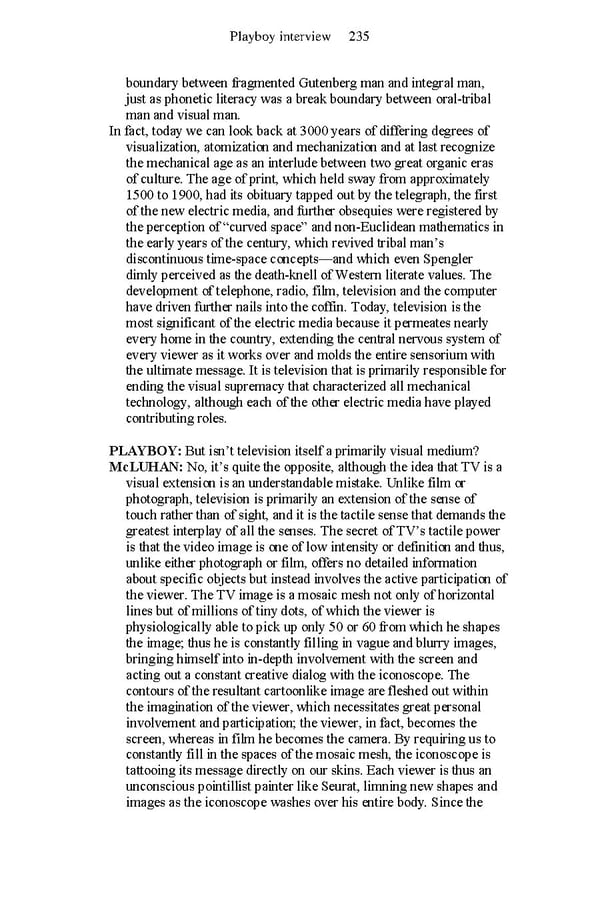Playboy interview 235 boundary between fragmented Gutenberg man and integral man, just as phonetic literacy was a break boundary between oral-tribal man and visual man. In fact, today we can look back at 3000 years of differing degrees of visualization, atomization and mechanization and at last recognize the mechanical age as an interlude between two great organic eras of culture. The age of print, which held sway from approximately 1500 to 1900, had its obituary tapped out by the telegraph, the first of the new electric media, and further obsequies were registered by the perception of “curved space” and non-Euclidean mathematics in the early years of the century, which revived tribal man’s discontinuous time-space concepts—and which even Spengler dimly perceived as the death-knell of Western literate values. The development of telephone, radio, film, television and the computer have driven further nails into the coffin. Today, television is the most significant of the electric media because it permeates nearly every home in the country, extending the central nervous system of every viewer as it works over and molds the entire sensorium with the ultimate message. It is television that is primarily responsible for ending the visual supremacy that characterized all mechanical technology, although each of the other electric media have played contributing roles. PLAYBOY: But isn’t television itself a primarily visual medium? McLUHAN: No, it’s quite the opposite, although the idea that TV is a visual extension is an understandable mistake. Unlike film or photograph, television is primarily an extension of the sense of touch rather than of sight, and it is the tactile sense that demands the greatest interplay of all the senses. The secret of TV’s tactile power is that the video image is one of low intensity or definition and thus, unlike either photograph or film, offers no detailed information about specific objects but instead involves the active participation of the viewer. The TV image is a mosaic mesh not only of horizontal lines but of millions of tiny dots, of which the viewer is physiologically able to pick up only 50 or 60 from which he shapes the image; thus he is constantly filling in vague and blurry images, bringing himself into in-depth involvement with the screen and acting out a constant creative dialog with the iconoscope. The contours of the resultant cartoonlike image are fleshed out within the imagination of the viewer, which necessitates great personal involvement and participation; the viewer, in fact, becomes the screen, whereas in film he becomes the camera. By requiring us to constantly fill in the spaces of the mosaic mesh, the iconoscope is tattooing its message directly on our skins. Each viewer is thus an unconscious pointillist painter like Seurat, limning new shapes and images as the iconoscope washes over his entire body. Since the
 Essential McLuhan Page 241 Page 243
Essential McLuhan Page 241 Page 243